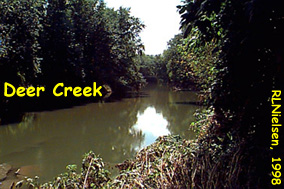

 Bacterial Ear Rot in Flooded Corn
Bacterial Ear Rot in Flooded Corn
Flooding of streams and rivers in late July do not always cause obvious damage to affected corn crops in adjacent fields, especially where the flood waters simply rise and fall quickly with little damage from moving water. Yet, the consequences of such flooding can be dramatic, especially if the flooding occurs near the time of pollination. Here is an example.
Intense rains in Carroll County during the third week of July resulted in extensive flooding of Deer Creek for a short period of time. Flood waters spread out through adjacent corn fields to heights greater than that of the developing ear shoots whose silks were just beginning to emerge from the husks. The water receded fairly quickly, leaving the corn plants covered with a thin layer of mud but with little other apparent damage.
A visit to one particular field one week later revealed that while pollen shed was occurring normally, silk elongation had stopped and the exposed silks were already dried up and brown. The plants themselves looked normal (albeit covered with a thin dry layer of mud) and the ear shoots themselves looked healthy from the outside.
Removing the husk leaves from the ear revealed that the upper half to two-thirds of the immature cob was discolored (gray), the sections of silk adjacent to the discolored cob were reddish-orange (according to Nielsen's eyes) or brown (Ruhl's eyes) and a distinctly objectionable odor wafted up from the rotting areas (sorry, no hot link available for odor!). Diagnosis of the ears back at Purdue's Plant and Pest Diagnostic Laboratory indicated that the cause of the problem was a bacterial rot.
The bacterial ear rot following flooded field conditions was most likely caused by one of several species of soft rot bacteria. These bacteria live as saprophytes on plant residue in the soil. During periods of high rainfall, flooding, overhead irrigation, or poor drainage, bacteria are splashed onto plants. The bacteria normally enter the plant through leaf stomates or wounds on leaves or stalks.
In the case of this field, it appears that the bacteria were carried in the flood water that rose above the young corn ears and then proceeded to seep down through the silks and husks of the young ears while they were submerged. As flood waters receded, the water trapped inside these ears provided optimal conditions for bacterial growth. Affected ears appeared normal on the outside, yet the bacteria were working within the husk, decomposing the cob, kernels, silks and leaf tissue from the inside. A soft, slimy texture and disagreeable odor that resembles spoiled silage accompanies the work of these soft rot bacteria.
Bottom Line: Don't wait until harvest to discover that a problem like this has occurred. Check fields that were flooded like this recently to determine the true extent of the damage.